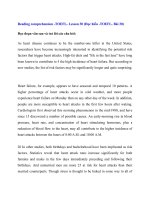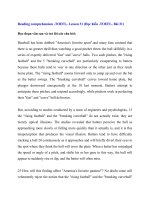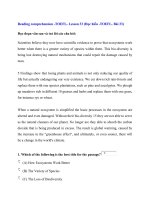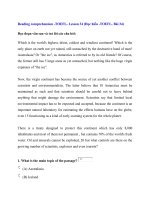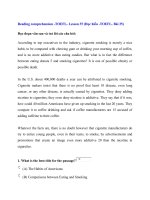Tài liệu Đọc hiểu -TOEFL- Bài 28 pot
Bạn đang xem bản rút gọn của tài liệu. Xem và tải ngay bản đầy đủ của tài liệu tại đây (45.38 KB, 4 trang )
Reading comprehension -TOEFL- Lesson 28 (Đọc hiểu -TOEFL- Bài 28)
Đọc đoạn văn sau và trả lời các câu hỏi:
Another common blues instrument that flourished in the rural South during the
1920s and 1930s was the blues harp or harmonica. It was played mainly in bands
called jug bands that commonly performed on street corners, in saloons, and at
country stores. Jug bands used 5 a variety of instruments including the banjo,
guitar, washboard, kazoo, fiddle, jugs, and blues harp. In these bands, the blues
harp was used primarily for melodic and rhythmic support. The earliest evidence of
the harp used as a solo or lead instrument in the jug bands was in the late 1920s, as
heard in the recordings of George 10 "Bullet" Williams. Other good harpmen, such
as Sonny Terry, Little Walter, and Sonny Boy Williamson, followed Williams,
revolutionizing the harp's role as a lead instrument.
1. What does the passage mainly discuss?
(A) twentieth-century music of the South
(B) a change in the role of the blues harp
(C) good harpmen of the traditional blues harp
B
(D) the variety of instruments in jug bands
2. The blues harp is another name for the
(A) harpsichord
(B) guitar
(C) harmonica
(D) banjo
3. The word "flourished" as used in line 1 could best be replaced by which of
the following?
(A) began to burgeon
(B) was profound
(C) appeared
C
A
(D) entertained
4. The author uses the phrase "rural South" in line 1 to refer to the Southern
(A) landscape
(B) metropolis
(C) countryside
(D) nation
5. It can be inferred that George "Bullet" Williams
(A) was the best blues harp player
(B) became friends with later harpmen
(C) played lead guitar in his band
C
D
(D) influenced some of the later harpmen
6. As used in line 7, the word "primarily" could best be replaced by
(A) chiefly
(B) peculiarly
(C) favorably
(D) advantageously
7. According to the author, when was the harp first used as a lead instrument?
(A) 1920-1925
(B) 1925-1930
(C) 1930-1935
A
B
(D) 1935-1940
8. The word "lead" as used in line 8 is closest in meaning to which of the
following?
(A) model
(B) only
(C) control
(D) principal
9. In line 9, the word "recordings" most likely refers to
(A) readings
(B) tapes
(C) records
D
C
(D) movies
10. The word "revolutionizing" in line 11 could best be replaced by which of
the following?
(A) reforming
(B) fighting
(C) resisting
(D) turning
11. Which of the following would most likely be the topic of the previous
paragraph?
(A) the use of instruments for rythmic support in rural southern music in the
1920s
(B) lead instruments in rural southern music of the 1920s
A
B
(C) music in the American rural South before 1920
(D) jug bands and their role in 1920s southern music
12. According to the passage, jug bands were likely to perform in all of the
following places EXCEPT
(A) on street corners
(B) at country suppers
(C) in concert halls
(D) in saloons
C




